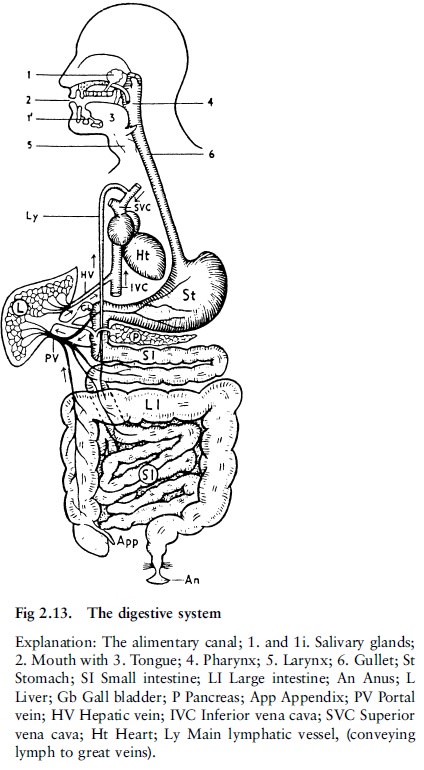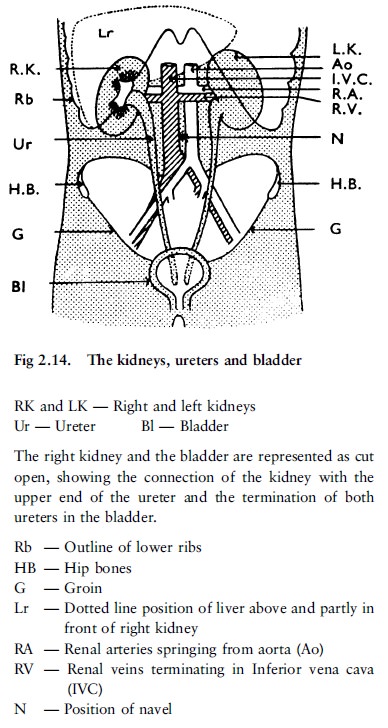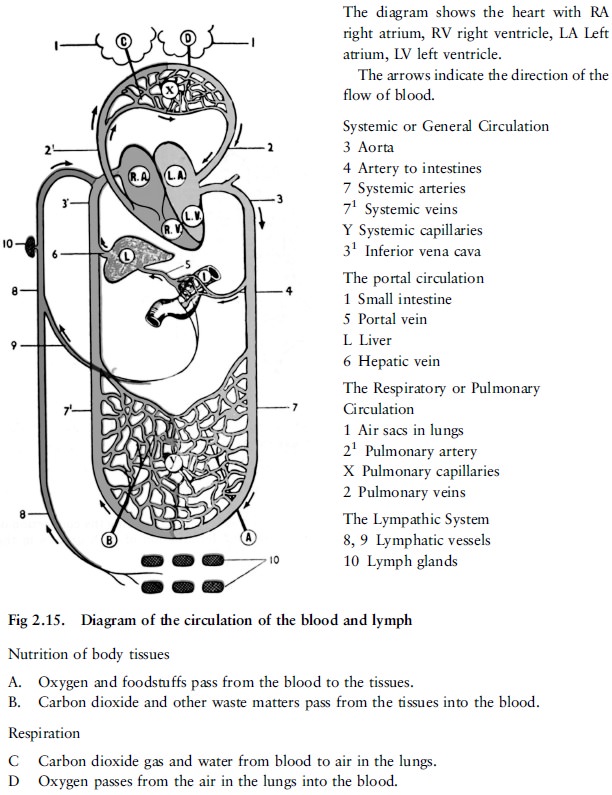Chapter: Forensic Medicine: Basic anatomy and physiology
The working of the body

The working of the body
The functioning of the body is activated by the
nervous system and performed by the muscular system and the main purpose of the
other organs is to keep nerves and muscles in the fit and healthy condition
necessary to do their work. The energy for this work is derived from food and
from the oxygen which is taken into the blood via the lungs during breathing.
The body uses food in three distinct stages namely:
·
digestion
·
absorption
·
elimination
The digestion stage (fig 2.13)
Food is prepared for digestion and digested by
the digestive organs in the following manner: food is broken up into smaller
particles by the action of chewing, and becomes warm and moist. The chemical
action of the digestive juices splits these particles into simple substances
which are soluble in water, allowing them to be taken up more easily into the
body. The action of the digestive juices is helped by the mixing and churning
movements of the involuntary muscles of the stomach and intestines (also called
plain or smooth muscles because they are not striped as are the skeletal or
voluntary muscles).
In the mouth the food is broken up by chewing,
and moistened by saliva, a digestive juice poured into the mouth from several
glands (salivary glands)

situated near it. The act of swallowing passes
the moistened food down the gullet into the stomach. The stomach acts as a
reservoir in which the food is retained until it is thoroughly warmed and
reduced to a fluid condition. The walls of the stomach pour out a second juice
(gastric juice) which also acts upon the food. Upon leaving the stomach the
partially digested food enters the small intestine in a liquid state, and is
there acted upon by the digestive juice of the pancreas (pancreatic juice). The
bile also acts to some extent upon the food. At the same time the walls of the
intestine also secrete a digestive juice (the intestinal juice). The small
intestine is the main area in which digestion takes place.
Thus, in its passage through the digestive
canal, food is continuously undergoing change. Finally, after passing through
the large intestine, the undigested and unabsorbed remainder of the food is
expelled from the body. The passing of the food through the digestive canal
takes about 24 hours.
A normal diet contains, in proportions suited to
the needs of the body, the following three main classes of nutrients:
·
Nitrogenous nutrients found mainly in animal foods (meat, fish, etc),
and which also form the main part of these foods. Several vegetable foods,
however, also contain a considerable amount of nitrogenous nutrients.
·
Starches and sugars, found mainly in vegetables, bread, potatoes, sugar,
fruits, etc. Meats contain virtually no starch or sugar.
·
Fats, found for example in butter, oil, meat, fat and cream.
While all these nutrients serve as sources of
energy, it is chiefly starches, sugars and fats which supply energy. In a
normal diet starches, sugars and fats amount to more than three-quarters of the
total food intake. The main use of nitrogenous nutrients is to repair the
break-down in the living structures of the body.
In addition to these nutrients a normal diet
contains mineral salts and vitamins. These are necessary to the body, but they
are not sources of energy, and the same is true of the water which we drink.
Digestive juices act upon the nutrients in
different ways. Saliva only acts upon starches in the food, and gastric juice
mainly upon the nitrogenous nutrients. Gastric juice is the only acid digestive
juice, and for this reason it has an important action in checking the
development of any infective germs which may have been swallowed.
Partially digested foodstuffs are acted upon in
the small intestine by pancreatic juice, bile, and intestinal juice. All these
are alkaline juices, and together they aid digestion, but the strongest is
pancreatic juice. By the joint action of these juices the digestion of all
three classes of nutrients is continued and completed in the small intestine
where they are reduced to the simple forms in which they can be absorbed into
the body.
In the lower part of the small intestine and in
the large intestine a certain amount of putrefactive change also takes place.
This is due not to the digestive juices, but to the action of germs or
bacteria.
Use of foods and oxygen in the body
The nutrients which have been prepared by
digestion are absorbed (ie taken up through the walls of the stomach and
intestines) and passed directly or indirectly into the blood. The small
intestine is the chief area where absorption of the nutrients take place.
Water, however, is largely absorbed in the large intestine.
There are two separate pathways by which the
various nutrients reach the general bloodstream of the body:
·
Nitrogenous nutrients together with sugars, salts and water are taken
into the blood mainly in the walls of the small intestine. They are then
carried by a large blood vessel, the portal vein (fig 2.13 PV), to the liver
and are to some extent acted upon by that organ before they reach the general
bloodstream of the body through the veins leaving the liver (fig 2.13 HV). This
special system is known as the portal circulation. In addition to other
important functions the liver has to store the sugars and prepare them for
further use in the body. Any substances (including poisons) absorbed from the
gut must thus pass via the bloodstream to the liver, where they could (as in
the case of poisons) damage the liver, or be modified by it.

·
Fats, on the other hand, are taken up by the lymphatic vessels of the
small intestine and pass through these to veins and so to the general
circulation (fig 2.15).
Both pathways of absorption are shown in fig
2.15. A further description of the portal circulation and of the lymphatic
vessels will be found in the next section.

The body is a living ``machine'' and its living
structures or tissues make use of the nutritional substances and oxygen in
order to:
·
perform mechanical and other forms of labour
·
maintain bodily heat
·
repair the constant decline of living structures
In a steam engine coal and oxygen from the air
are used similarly to produce heat, which in turn result in useful activity. In
the body there is less active ``burning'' or oxidation of nutritional
substances which are absorbed in the lungs and blood. In both cases energy is
produced in the form of heat, resulting in activity. The burning of coal in the
engine converts the coal into smoke and ash. So too the activity of bodily
tissues in consequence of oxidation and the conversion of food produce certain
waste material of which the body must rid itself.
The most important of these waste materials are:
·
carbon dioxide
·
water
·
urea
Excretion of waste matter
The process of removing waste matter from the blood and from the body is called excretion.
Carbon dioxide is eliminated by the lungs into
the air through breathing. The lungs also give off a considerable quantity of
water as moisture in the breath. The lungs thus serve the dual purpose of
taking up oxygen from the air into the blood, and of eliminating carbon dioxide
from the blood to the air. This is the essential purpose of respiration or
breathing.
Water, along with a small quantity of other
waste substances, is eliminated by the skin in the form of sweat. The kidneys
withdraw from one to one-and-a-half litres of water daily from the blood which
contains dissolved mineral salts and several other important forms of waste
matter (the most important being urea). These form the urine. The urine passes
down from the kidneys to the bladder, from where it is expelled (fig 2.14).

Other waste matter is eliminated by the liver in
the bile, and this together with the unabsorbed and undigested portions of the
food is expelled from the body through evacuation of the bowels, as faeces or
stools. The faeces also contain countless numbers of germs or bacteria, as well
as a variety of viruses and yeast.
Related Topics